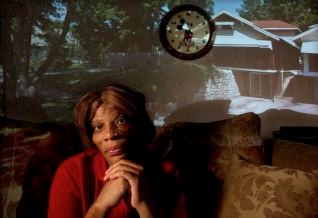 Usually stories about Child Protective Service workers only involve terrible incidents where they are brought in to respond to a local case of abuse, or worse where they were not called in time. Recently though the Houston Chronicle profiled Amy Woodard-Davis an adoption caseworker with the agency with her own astonishing story of survival as an unwanted infant who survived among the worst cases of abuse imaginable. And yet, despite it all, she seems to thrive even while confronting details of a past she had been shielded from for decades as a child brought to Texas originally to get treatment at Galveston’s Shriner’s Hospitals for Burned Children.
Usually stories about Child Protective Service workers only involve terrible incidents where they are brought in to respond to a local case of abuse, or worse where they were not called in time. Recently though the Houston Chronicle profiled Amy Woodard-Davis an adoption caseworker with the agency with her own astonishing story of survival as an unwanted infant who survived among the worst cases of abuse imaginable. And yet, despite it all, she seems to thrive even while confronting details of a past she had been shielded from for decades as a child brought to Texas originally to get treatment at Galveston’s Shriner’s Hospitals for Burned Children.
“The truth about her life arrived in a yellow envelope six years ago. It came in the form of 31 news articles.
Amy Woodard-Davis had been eagerly awaiting the package from the Kansas City, Kan., library. Amy then fed and bathed her 3-year-old daughter, Jailynn, before sending her off to play that February afternoon in 2006. She walked into her room, sat on her bed and calmly opened the envelope.
She took out photocopied newspaper clippings and began to read each article, slowly, without hesitating, until she had read them all. As her eyes scanned the stories, the same words jumped out over and over: “newborn,” “fire,” “abandoned,” “burned.”
The story chronicled in those clippings could easily have been any of the abused and neglected children Amy would help find homes for a year later when she become an adoptions caseworker at Child Protective Services.
To Amy, it read like an interesting novel, the protagonist “baby girl X,” as she was called, struggling to fight for her life, against the dire predictions of doctors. But reality would settle in after every few articles, reminding the 41-year-old of what she was reading.
“This is me,” she said. “This is about me.”On March 26, 1971, Amy’s mother, at 16, gave birth to her in the bathroom of her Kansas City home. Amy was only alive a few hours when her grandfather pulled the newborn, wrapped in newspaper, from a burning pile of trash in their backyard.
He thought he heard a kitten’s cries, only to discover they were a baby’s whimpers. He grabbed the newborn from the trash, put her in a towel and called the fire department.
Third- and fourth-degree burns covered more than half of Amy’s tiny frame. Her injuries were so severe doctors at first could not determine her race.
It would be a few days before authorities discovered that Amy was most likely dumped in the trash barrel, in a fire that was apparently already burning, by her mother who found out she was pregnant only after she gave birth. The teen was never prosecuted in the case.
This truth about how she came into the world motivated Amy to learn more about her story.
A couple months after reading those articles, she stood on the doorstep of the home where it all happened, where she was born and burned, where her mother still lived, looking at the woman responsible for giving her life and suspected in her near death, asking for answers.
